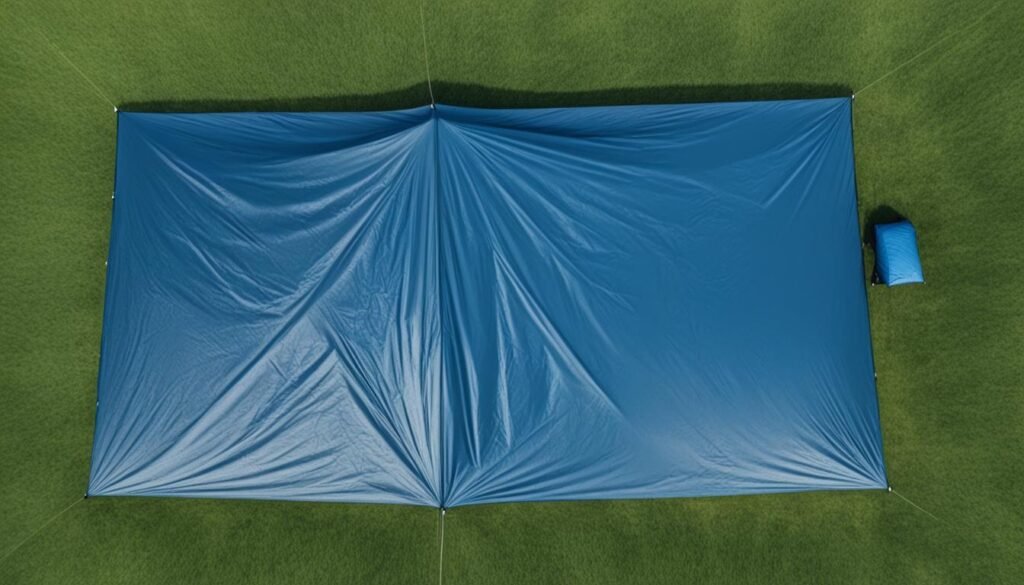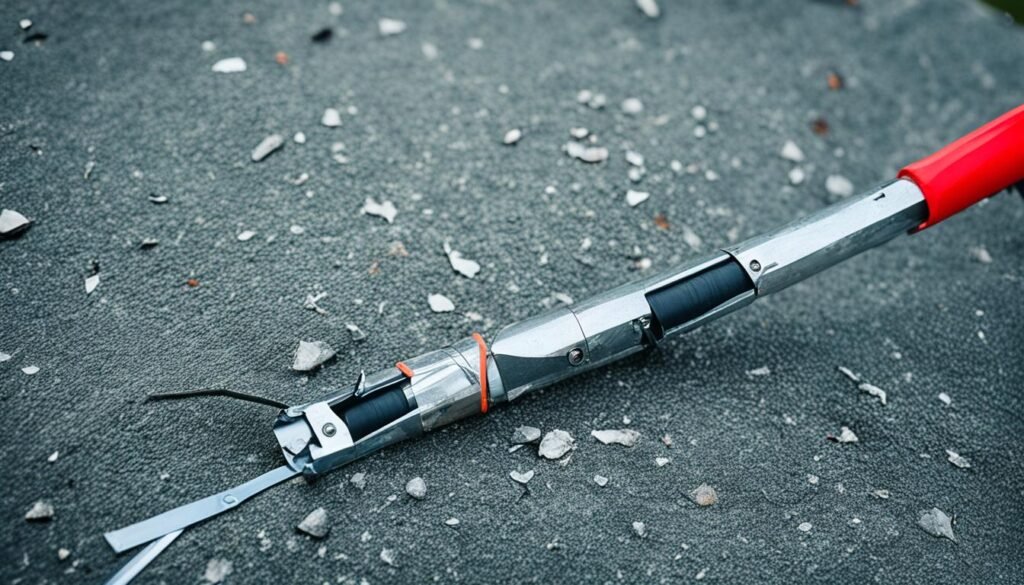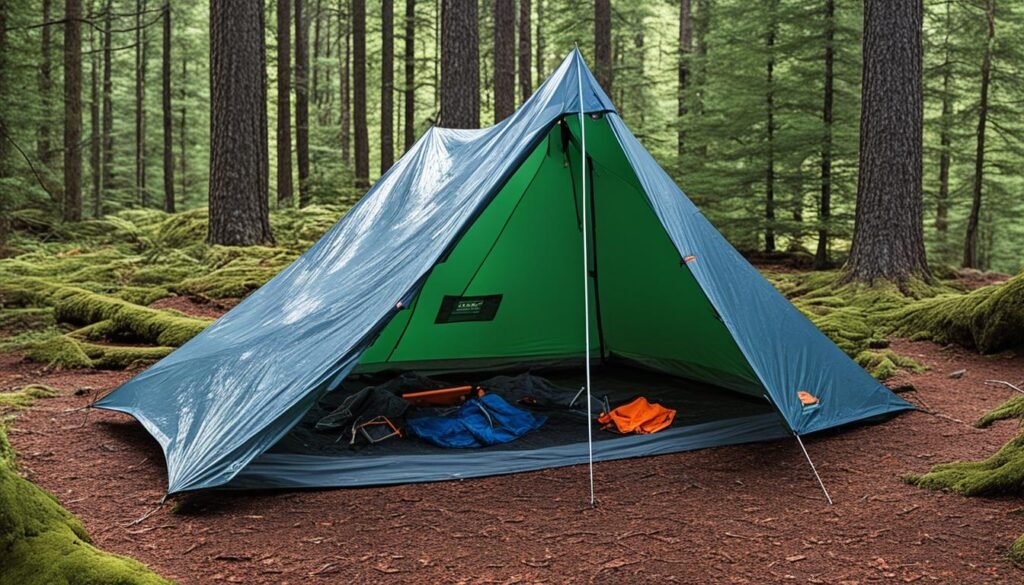Taking good care of your tent is essential for maximizing its lifespan and getting the most out of your gear investment. As an avid camper, I understand the importance of keeping your tent in top shape. In this article, I will share essential tent repair tips and DIY tent repairs that you can easily perform in the field. Whether it’s patching tears, fixing zippers, or sealing leaks, I’ll guide you through the process so that you can handle common tent maintenance tasks with confidence.
However, it’s important to note that not all repairs can be done on your own. If your tent’s repair needs are beyond your comfort or skill level, it’s always best to consider professional repair services. They have the expertise and specialized equipment to tackle complex repairs and ensure your tent is in its best condition.
Key Takeaways:
- Regular tent maintenance and repair can extend its lifespan.
- DIY tent repairs in the field can save you time and money.
- For more complex repairs, professional services are available.
- Inspect your tent before each trip to identify any repair needs.
- Proper tent care and storage techniques are crucial for longevity.
DIY Tent Repairs in the Field
When you’re out in the wilderness, having the know-how to perform DIY tent repairs can be a game-changer. With the right supplies and a little bit of guidance, you can fix minor damages and keep your tent in top shape for more adventures to come. In this section, I’ll share some essential DIY tent repair methods that you can easily implement while camping or backpacking.
Fixing Holes in the Tent Fabric
-
To fix a hole in your tent fabric, you’ll need the following supplies:
- Rubbing alcohol
- A rag
- Scissors
- Repair tape (such as Tenacious Tape™)
- A mesh patch (if patching a mesh door or window)
- Clean the fabric around the tear using rubbing alcohol and a rag.
- Prep the repair tape by cutting it to the appropriate size and shape.
- Apply the repair tape to the hole, ensuring it firmly adheres to the fabric.
- If the hole is on a mesh door or window, you can add an interior mesh patch for added strength and stability.
- Allow the patch to cure completely before folding or packing the tent away.
Repairing a Sticky Tent Zipper
Dealing with a sticky zipper can be frustrating, but fear not! You can easily get your zipper back in working order with a few simple steps.
- Clean the zipper of any debris using a soft cloth or brush.
- If the zipper is still sticking, you can try using an unscented candle as a temporary lubricant while in the field.
- For a long-term solution, apply a zipper clean/lube product to keep your zipper running smoothly. This can be done when you’re back home.
- Remember, avoid forcing the zipper as it can cause more damage.
Sealing Leaks in the Tent Seams
“A leaky tent seam can quickly turn a cozy camping trip into a damp nightmare. But with some simple seam sealing techniques, you can keep the water out and enjoy a dry night’s sleep.”
Here’s how you can seal leaks in your tent seams:
| What You’ll Need | How to Do It |
|---|---|
|
|
By following these DIY tent repair methods, you’ll be equipped to handle common issues that can arise during field trips. However, keep in mind that more complex repairs are best left for when you have access to proper tools and resources at home. So, enjoy your camping adventure with the peace of mind that you can fix minor damages on the go.
Fixing Holes in the Tent Fabric
When you discover a hole in your tent fabric, it’s important to address it promptly to prevent further damage. Follow these steps to successfully repair the hole:
- Clean the fabric: Begin by cleaning the area around the tear. Use a rag dampened with rubbing alcohol to remove any dirt or debris that may hinder the repair process.
- Prep the repair tape: Cut a piece of repair tape, such as Tenacious Tape™, slightly larger than the hole. This durable adhesive tape is designed specifically for repairing tents.
- Apply the tape: Carefully place the repair tape over the hole, ensuring complete coverage. Press down firmly to ensure a secure bond between the tape and the fabric.
- Add an interior patch: If the hole is large or positioned in a high-stress area, it may be beneficial to reinforce the repair with an interior patch. Cut a piece of mesh patch material, if necessary, and affix it to the inside of the tent fabric using the same adhesive tape.
- Let the patch cure: Allow the repair tape and any interior patches to fully cure according to the manufacturer’s instructions. This ensures a strong and long-lasting repair.
Once the patch is fully cured, your tent fabric should be ready for use. Remember to inspect your tent before each trip and perform any necessary repairs to maintain its integrity.
| Materials Needed | Instructions |
|---|---|
| Rubbing alcohol | Clean the area around the tear with a rag dampened in rubbing alcohol. |
| Scissors | Cut a piece of repair tape slightly larger than the hole. |
| Repair tape (such as Tenacious Tape™) | Apply the repair tape over the hole, pressing down firmly to ensure adhesion. |
| Mesh patch (if necessary) | Add an interior patch for additional reinforcement, if needed. |
Why is it important to repair tent fabric promptly?
A small hole in the tent fabric might not seem like a big concern, but it can lead to more significant tears if left unrepaired. Additionally, a hole compromises the tent’s waterproofing capabilities, making it vulnerable to leaks during rainy weather. By fixing holes in the tent fabric promptly, you ensure the longevity and functionality of your tent.
Fixing Holes in the Tent Mesh
If you discover that your tent’s mesh netting has been snagged or torn, don’t worry—there are solutions to fix it. For minor damage, you can try working the strands back together. However, for more severe holes or tears, using a mesh patch is the best option to ensure a sturdy repair.
Repairing Minor Damage
If the mesh damage is minimal, you may be able to fix it by carefully reweaving the strands of the mesh. Gently work the strands back together using a needle or a small crochet hook. Take your time and ensure that all strands are properly aligned to restore the mesh’s integrity. This method is suitable for minor snags or small tears that haven’t compromised the overall structure of the mesh.
Using a Mesh Patch for Severe Damage
For more significant damage, such as larger holes or tears, using a mesh patch is the preferred repair method. Here’s how you can fix holes in the tent mesh:
- Set up your work area by placing the tent on a flat surface with adequate lighting.
- Prep the mesh patch by cutting it to the appropriate size, ensuring it covers the entire damaged area with a small overlap. It’s best to use a mesh patch made from the same material as your tent to maintain consistency.
- Align the mesh patch over the hole or tear, ensuring that the pattern of the mesh matches. The patch should be centered and cover the damaged area completely.
- Apply an adhesive suitable for the tent material around the edges of the hole or tear. Ensure that the adhesive is evenly distributed for maximum adhesion.
- Gently press the mesh patch onto the adhesive, smoothing out any wrinkles or bubbles. Apply light pressure to ensure a secure bond.
- Allow the adhesive to cure according to the manufacturer’s instructions. This typically takes a few hours to overnight.
Once the adhesive has fully cured, carefully inspect the repair to ensure it is secure and functional. If done properly, the mesh patch should seamlessly blend with the surrounding mesh, providing a strong and durable fix.
If you don’t have a specific mesh patch on hand, a solid patch can be used as a temporary solution. While not as ideal as a mesh patch, it can provide a quick fix to prevent further damage until a proper repair can be made.
Remember, it’s essential to repair any damage to your tent as soon as possible to maintain its integrity and prolong its lifespan. Neglecting to address holes or tears in the mesh can lead to more significant issues down the line, compromising the overall functionality of your tent.
| Repair Method | Pros | Cons |
|---|---|---|
| Reweaving the strands | – Suitable for minor damage – No need for additional materials |
– Limited to minor snags or tears – Does not work for larger holes or tears |
| Using a mesh patch | – Provides a strong and durable repair – Ensures proper ventilation through the mesh |
– Requires a mesh patch and adhesive – More time-consuming than reweaving strands |
Repairing a Sticky Tent Zipper
A sticky zipper can be a frustrating problem when setting up or packing away your tent. However, don’t worry because it can often be resolved with some simple maintenance techniques. Here’s what you need to do:
- Clean the zipper: Start by cleaning the zipper of any debris or dirt. Use a soft cloth or brush to gently remove any particles that may be causing the stickiness.
- Temporary fix with an unscented candle: If the zipper continues to stick, you can try a temporary fix with an unscented candle. Simply rub the candle wax along the affected area of the zipper, then gently slide the zipper back and forth to distribute the wax. This can provide temporary lubrication and make the zipper easier to operate.
- Apply a zipper clean/lube product: When you get home, it’s a good idea to give your tent zipper some extra care. Look for a specialized zipper clean/lube product designed specifically for outdoor gear. Apply the product according to the manufacturer’s instructions to ensure smooth zipper operation in the future.
- Avoid forcing the zipper: It’s important to avoid forcing the zipper when it’s sticking. Pulling or tugging too hard can potentially cause more damage to the zipper or the surrounding fabric. Take your time and be patient while operating the zipper.
By following these steps, you can effectively fix a sticky zipper, ensuring hassle-free tent setup and takedown.
Tent Zipper Maintenance Tips:
Proper zipper maintenance is essential to prevent sticky situations. Here are a few additional tips to keep your tent zipper in top shape:
- Regularly inspect the zipper for any signs of wear or damage, such as fraying or bent teeth.
- Keep the zipper clean by wiping it with a damp cloth or using a soft brush to remove any dirt or debris.
- Avoid overstuffing your tent bag, as this can put unnecessary strain on the zipper.
- When packing away your tent, make sure the zipper is fully closed to avoid snagging.
By incorporating these zipper maintenance practices into your tent care routine, you can extend the lifespan of your tent and ensure smooth zipper operation for future camping adventures.
Sealing Leaks in the Tent Seams
Tent seams can be vulnerable to leaks, so periodic inspection and maintenance are essential. To ensure a watertight tent, it’s important to know how to seal the seams properly. Follow this simple tent seam sealer tutorial to keep your tent dry and protected.
Here’s what you’ll need:
- Rag
- Rubbing alcohol
- Seam sealer suitable for your tent’s fabric coating
Now, let’s get started on sealing those pesky leaks:
- Set up your work area by finding a well-ventilated space with good lighting.
- Inspect your tent thoroughly and identify problem areas where leaks or loose seam tape are present.
- Use the rag and rubbing alcohol to clean the seams. This will remove any dirt, grime, or old seam sealer that may interfere with the new sealing process.
- Once the seams are clean and dry, it’s time to apply the new seam sealer. Follow the manufacturer’s instructions on how to apply the sealer to your specific tent fabric. Typically, you’ll use a small brush or applicator to spread a thin, even layer of the sealer over the seam.
- Pay extra attention to areas that are prone to leaks, such as the corners, flysheet seams, and floor seams.
- Allow the seam sealer to dry completely before packing away your tent. The drying time will vary depending on the sealer you use, so be sure to check the instructions.
Pro Tip:
Before applying the seam sealer, make sure you remove any loose or damaged seam tape. This will ensure a clean and effective seal.
By sealing your tent seams regularly, you can waterproof your tent and protect it from moisture, extending its lifespan and ensuring a comfortable camping experience, rain or shine.
Splinting a Broken Tent Pole
A broken or bent tent pole can be a significant inconvenience, but with the right tools, you can splint the pole in the field for temporary repair. Whether you’re in the middle of a camping trip or facing adverse weather conditions, splinting can provide a quick fix to keep your tent standing strong.
To begin splinting a broken tent pole, follow these steps:
- Prepare the pole: Clear any dirt or debris around the breakage point. Gently straighten any bent sections, taking care not to further damage the pole.
- Slide on a repair sleeve or use a tent stake: If you have a repair sleeve, carefully slide it over the broken section of the pole, ensuring a snug fit. Alternatively, if a repair sleeve is not available, a tent stake can be used as a temporary splint by inserting it alongside the broken area.
- Secure the repair with tape: Wrap strong tape, such as duct tape or repair tape, tightly around the repair sleeve or tent stake. This will hold the splint in place and provide additional stability.
It’s important to note that splinting is a temporary solution and should only be used until you have the opportunity to replace or permanently repair the pole when you return home. Continuing to use a splinted pole over an extended period may compromise its structural integrity and potentially lead to further damage.
Remember, safety should always be a priority when dealing with broken tent poles. Exercise caution and ensure that the repaired pole is stable before using your tent. When in doubt, consult a professional repair service to address the issue properly.
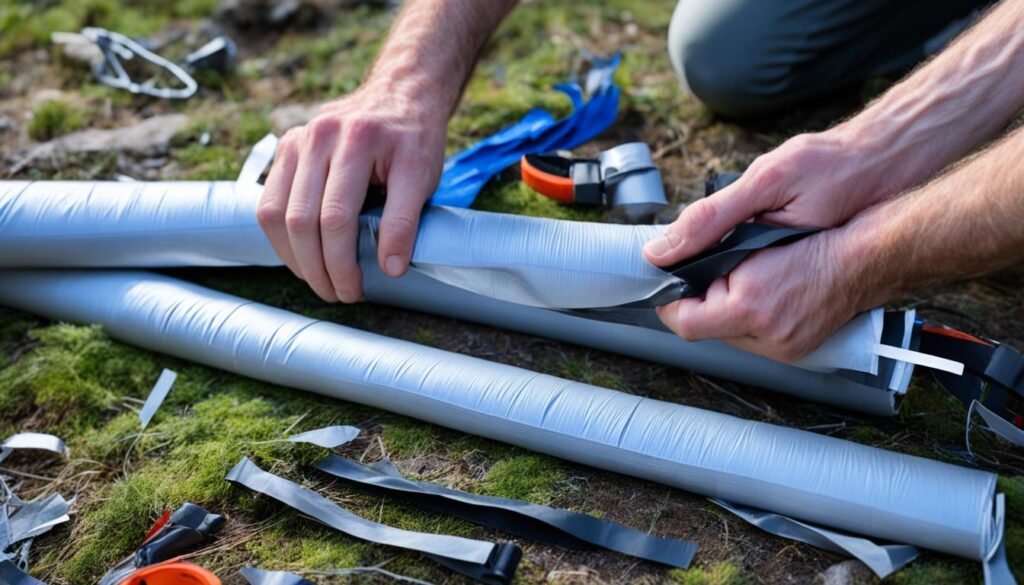
Expert Tip
“If you anticipate that your tent poles may be prone to damage, consider carrying a spare section of pole and repair tools in your camping gear. This way, you’ll be prepared for any unexpected pole failures and can respond quickly to keep your tent in optimal condition.”
Tent Care Basics for Longevity
Proper tent care is crucial for prolonging its lifespan. By following these essential tent care tips, you can ensure that your tent stays in good shape for years to come:
- Clean and dry your tent before storing: After each trip, make sure to clean your tent of any dirt, debris, or stains. Allow it to air dry completely before packing it away. Avoid storing a wet tent, as this can lead to mold and mildew growth, causing damage to the fabric.
- Inspect and repair: Before each camping trip, carefully inspect your tent for any signs of damage. Check for tears, holes, or loose seams. If you find any issues, make the necessary repairs using appropriate patching materials or tapes. Addressing small problems promptly can prevent them from worsening.
- Pick a suitable tent site: When pitching your tent, select a level ground that is clear of rocks and sharp objects that could potentially puncture the fabric. Inspecting the area and clearing away any potential hazards beforehand is essential.
- Use a tent footprint: Adding a tent footprint or groundsheet beneath your tent provides an extra layer of protection. It helps shield the tent floor from abrasion and moisture, extending its lifespan. Make sure the footprint is slightly smaller than the tent to prevent water from pooling between the layers.
Following these simple tent care tips will help you maintain the condition of your tent, prolong its lifespan, and ensure that it continues to serve you well on your outdoor adventures.
Prevention is Better Than Cure
A proactive approach to tent care can save you from dealing with major repairs. By following a comprehensive tent maintenance guide, you can avoid unnecessary damage and extend the lifespan of your tent. Here are some essential tips to help you prevent tent damage and avoid the need for extensive tent repairs:
- Avoid unnecessary strain: Be mindful of the limitations of your tent and avoid straining or stretching it beyond its capacity. Forcing the tent too far can lead to tears, broken poles, or damaged zippers.
- Choose a suitable tent site: Carefully select a tent site that is free from rocks, sharp objects, or debris that can cause tears or punctures. Clear the area before setting up your tent to minimize the risk of damage.
- Carry spare repair tools: Always have spare tent pegs, repair tape, adhesive, and other essential repair tools in your camping gear. These tools can come in handy for emergency repairs, allowing you to address minor issues before they escalate.
Remember, prevention is key to avoiding tent repairs and ensuring a smooth camping experience. By taking proactive measures and being mindful of your tent’s limitations, you can protect your investment and enjoy many years of outdoor adventures.
Proactive approach to tent care
“By following a comprehensive tent maintenance guide, you can avoid unnecessary damage and extend the lifespan of your tent.”
How to Store a Tent Properly
Proper storage is crucial for keeping your tent in good condition. By following these tent storage tips, you can prevent damage and ensure that your tent is always ready for your next camping adventure.
1. Pack away when dry: Always try to pack away your tent when it’s completely dry. Moisture trapped in the fabric can lead to mildew growth, which can degrade the tent’s material over time. If your tent gets wet during use, make sure to dry it thoroughly before storing.
2. Ensure complete dryness: Before packing up your tent, ensure that all parts of the tent are completely dry. This includes the tent body, rainfly, poles, and stakes. Check for any damp spots or moisture buildup, especially in seams, corners, and pockets.
3. Inspect for breakages: Take the time to inspect your tent for any breakages or damage before storing it. Look for tears in the fabric, holes in the mesh, or bent poles. Address any issues you find promptly by repairing or replacing the damaged parts to prevent them from worsening during storage.
4. Store in a dry and cool place: Choose a storage location that is dry and cool to prevent excessive heat or humidity from affecting your tent. Make sure the area is clean and free from pests that could damage the tent.
5. Use a storage bag or container: Invest in a proper storage bag or container designed for tents. These bags or containers help protect your tent from dust, dirt, and potential damage while in storage. Avoid compressing the tent too tightly to allow for airflow and prevent creasing.
6. Keep away from direct sunlight: Prolonged exposure to direct sunlight can cause the fabric to fade and weaken over time. Store your tent in a shaded area or use a cover to shield it from harmful UV rays.
7. Rotate the tent: To minimize the stress on certain areas of the tent, rotate it periodically during storage. This helps prevent the fabric from becoming weak or developing creases in the same spots over time.
8. Label and organize: If you have multiple tents or camping gear, label your storage bags or containers to easily identify and locate your tent when needed. Organize your storage area to maintain order and prevent accidental damage while retrieving other items.
By following these tent storage tips, you can prevent damage, prolong the lifespan of your tent, and ensure that it’s always in great condition for your outdoor adventures.
Checking Your Tent Before You Go
Before embarking on a camping trip, it’s essential to perform a thorough inspection of your tent. By taking the time to check your tent’s condition, you can identify any potential issues and fix them before they become a problem during your camping experience.
Tent Inspection Checklist
Follow this simple checklist to ensure you inspect all the crucial components of your tent:
- Set up your tent in a well-lit and spacious area.
- Examine the tent fabric carefully, looking for any tears, holes, or signs of wear.
- Check the tent’s seams for any fraying or separation.
- Inspect the zippers to make sure they are functioning smoothly.
- Verify the condition of the tent’s poles, ensuring they are not bent or damaged.
- Examine the tent’s guy lines and stakes, ensuring they are in good condition and not missing.
- Test the waterproofing of the tent by spraying water on the fabric to check for any leaks.
If you discover any tears, holes, or other damage during the inspection, it’s vital to address them before your camping trip. Depending on the severity of the damage, you can use repair tape, patches, or seek professional repair services to ensure your tent is in optimal condition.
Remember, a well-maintained tent enhances your camping experience and provides better protection from the elements.
Performing a pre-trip tent inspection gives you peace of mind and ensures a hassle-free camping adventure. By taking the time to check for any issues and addressing them beforehand, you’ll be able to enjoy the great outdoors without worrying about the integrity of your shelter.
Tent Pitching Tips for Durability
How you pitch your tent can greatly impact its durability. By following these tent pitching tips, you can ensure that your tent is set up properly and withstands the elements.
- Choose a level ground: Before pitching your tent, ensure that the ground is level. This will provide a stable and comfortable foundation for your tent.
- Clear away sharp objects: Clear the area of any sharp objects, such as rocks or branches, that may cause tears or punctures in the tent fabric.
- Avoid excess pressure: Be mindful of the amount of pressure you exert on the tent fabric while pitching. In windy conditions, avoid pulling the fabric too tightly, as it can strain the seams and zippers.
- Find a sheltered spot: Look for a sheltered spot away from thoroughfares to protect your tent from gusty winds and potential disturbances. This will minimize the stress on your tent and prevent damage.
Properly pitching your tent according to these guidelines will help preserve the lifespan of your tent and ensure that it serves you well for many camping adventures to come.
| Tent Pitching Tips | Description |
|---|---|
| Choose a level ground | Ensure that the ground is flat and even before pitching your tent. This provides stability and prevents discomfort during sleep. |
| Clear away sharp objects | Remove any sharp objects from the tent area, such as rocks or twigs, to avoid damaging the tent fabric. |
| Avoid excess pressure | When pitching your tent, avoid pulling the fabric too tightly, especially in windy conditions, as it can strain the seams and zippers. |
| Find a sheltered spot | Look for a location that offers natural protection from wind and potential disturbances. This helps reduce stress on the tent and increases its lifespan. |
Always Be Prepared for Repairs
Being prepared for tent repairs is essential for a seamless camping experience. By carrying a comprehensive tent repair kit, you can quickly and efficiently address any unexpected damages that may arise during your outdoor adventures. A well-equipped repair kit ensures that you have all the essential tools at hand to handle various types of tent repairs. Here are some of the crucial items to include in your tent repair kit:
Essential Repair Tools:
- Repair tape: A versatile adhesive tape that can be used to patch small tears or holes in your tent fabric or mesh.
- Spare patches: Pre-cut patches of tent fabric or mesh for larger repairs or to reinforce weakened areas.
- Adhesive: A strong adhesive for securely bonding materials together during the repair process.
- Needle and thread: For situations where stitching is necessary, such as repairing torn seams or attaching patches.
- Cleaning supplies: A rag and rubbing alcohol to clean the repair area before applying patches or adhesive.
Having these essential repair tools readily available in your tent repair kit will ensure that you are prepared to handle various tent damage scenarios. Additionally, it’s essential to restock your repair kit after each trip to replenish any used items and ensure that you’re always ready for any tent repair needs that may arise.
| Repair Tool | Function |
|---|---|
| Repair tape | Patches small tears or holes in tent fabric or mesh. |
| Spare patches | Pre-cut patches for larger repairs or reinforcement. |
| Adhesive | Bonds materials securely during the repair process. |
| Needle and thread | For stitching torn seams or attaching patches. |
| Cleaning supplies | Rag and rubbing alcohol for cleaning repair areas. |
Restocking Your Repair Kit
After each camping trip, it’s vital to assess the contents of your tent repair kit and replenish any used or depleted items. Check the condition of your repair tape, spare patches, adhesive, needle and thread, and cleaning supplies. Replace any items that have expired or become less effective. By restocking your repair kit, you can ensure that it remains fully equipped to handle any tent repair emergencies that may arise in the future.
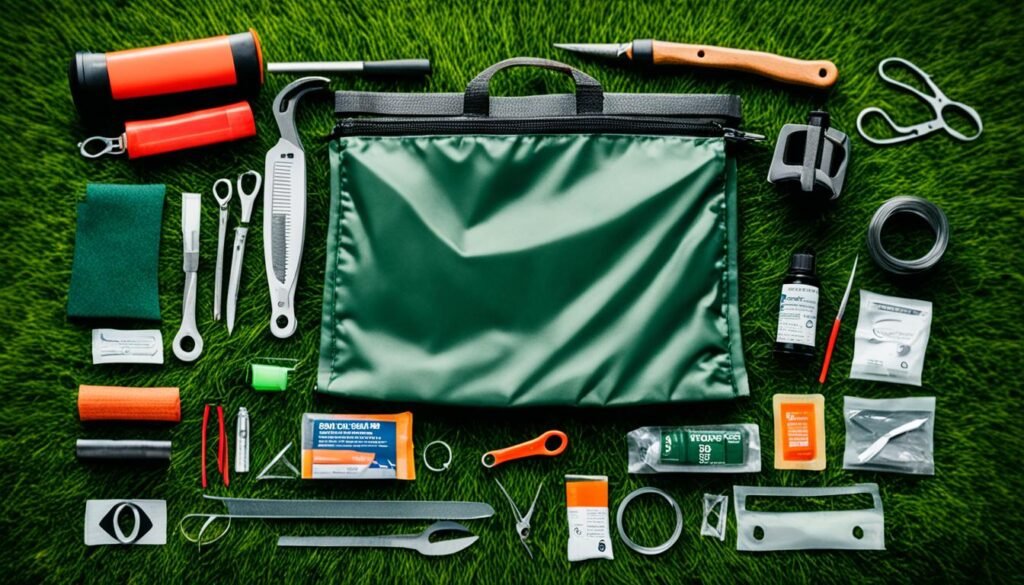
Always be prepared for tent repairs by having a well-stocked tent repair kit at your disposal. With the essential repair tools on hand, you can quickly address any tent damage, ensuring that your camping trips remain enjoyable and uninterrupted. By taking a proactive approach to tent maintenance and repair, you can extend the lifespan of your tent and continue to embark on countless outdoor adventures.
Can the Techniques for Repairing Canvas Tents Also be Applied to Regular Tents?
Yes, the techniques for repairing canvas tents can also be applied to regular tents. When it comes to canvas tent repairs, fixing rips can typically be done using patching materials, sewing, or adhesive tape. These same methods can be used to mend tears and holes in regular tents as well.
Conclusion
Proper maintenance and repair can significantly extend the lifespan of your tent, saving you time, money, and unnecessary waste. By performing DIY tent repairs in the field and taking preventive care measures, you can keep your tent in excellent condition for years of outdoor adventures.
It’s important to prioritize regular inspections and address any repair needs promptly. Simple repairs like patching holes in the fabric or mesh, fixing a sticky zipper, or sealing leaks in the seams can often be done yourself with the right tools and supplies. However, for more complex repairs or if you’re unsure about handling a repair yourself, professional repair services are available.
Remember to take pride in caring for your tent. With proper maintenance, you can enjoy many more memorable camping experiences. So, make sure to clean and dry your tent before storage, pitch it on level ground, and avoid unnecessary strain. With these tips and a proactive approach to tent care, you’ll maximize the longevity of your tent and ensure it stays in top condition for all your outdoor adventures.
FAQ
Why is tent care important?
Taking good care of your tent is essential for maximizing its lifespan and getting the most out of your gear investment.
What tent repairs can be done in the field?
You can easily perform simple tent repairs in the field, such as fixing holes in the tent fabric or mesh, repairing a sticky zipper, and sealing leaks in the seams.
How can I fix a hole in my tent fabric?
To fix a hole in your tent fabric, clean the area, apply repair tape, and add an interior patch if necessary.
How do I repair holes in the tent mesh?
You can repair holes in the tent mesh by working the strands back together or using a mesh patch.
How can I fix a sticky tent zipper?
Clean the zipper, consider temporary fixes like using an unscented candle, and apply a zipper clean/lube product when you get home.
How do I seal leaks in my tent seams?
Clean the seams, apply seam sealer suitable for your tent’s fabric coating, and allow it to dry completely.
What should I do if my tent pole breaks?
Splint the pole in the field for temporary repair using a repair sleeve or tent stake, but replace or permanently repair the pole when you return home.
How can I prolong the lifespan of my tent?
Proper tent care is crucial, including cleaning and drying before storage, checking for damage before each trip, and using a tent footprint for added protection.
How can I prevent tent damage?
Avoid stretching or forcing the tent too far, choose a suitable tent site, and carry spare tent pegs and repair tools for emergencies.
What is the proper way to store a tent?
Always pack away your tent when it’s dry, ensure all parts are dry before storage, and inspect and fix any breakages or damage.
Should I check my tent before going on a camping trip?
Yes, it’s important to set up your tent and inspect it thoroughly for any tears, holes, or other damage before leaving.
What tent pitching tips should I follow?
Choose a level ground, clear sharp objects, avoid exerting too much pressure, and find a sheltered spot away from wind and disturbances.
Why should I always be prepared for tent repairs?
Being prepared with a tent repair kit and essential tools means you can quickly handle any necessary repairs during your camping trips.
How can proper maintenance and repair extend the lifespan of my tent?
Proper maintenance and repair can significantly extend the lifespan of your tent, saving you time, money, and unnecessary waste. By performing DIY tent repairs in the field and taking preventive care measures, you can keep your tent in excellent condition for years of outdoor adventures. If more substantial repairs are needed or you’re unsure about handling a repair yourself, professional repair services are available. Take pride in caring for your tent and enjoy many more memorable camping experiences.


